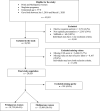Maternal childbirth experience and time in labor: a population-based cohort study
- PMID: 35831421
- PMCID: PMC9279318
- DOI: 10.1038/s41598-022-14711-y
Maternal childbirth experience and time in labor: a population-based cohort study
Abstract
A negative childbirth experience may have long term negative effects on maternal health. New international guidelines allow a slower progress of labor in the early active phase. However, a longer time in labor may influence the childbirth experience. In this population-based cohort study including 26,429 women, who gave birth from January 2016 to March 2020, the association between duration of different phases of active labor and childbirth experience was studied. The women assessed their childbirth experience by visual analogue scale (VAS) score. Data was obtained from electronic medical records. The prevalence of negative childbirth experience (VAS 1-3) was 4.9%. A significant association between longer duration of all labor phases and a negative childbirth experience was found for primi- and multipara. The adjusted odds ratio (aOR (95%CI)) of negative childbirth experience and longer time in active labor (above the 90th percentile) in primipara was 2.39 (1.98-2.90) and in multipara 2.23 (1.78-2.79). In primi-and multipara with duration of labor ≥ 12 h or ≥ 6 h the aOR (95%CI) of negative childbirth experience were 2.22 (1.91-2.58) and 1.91 (1.59-2.26) respectively. It is of great importance to identify and optimize the clinical care of women with longer time in labor to reduce the risk of negative childbirth experience and associated adverse long-term effects.
© 2022. The Author(s).
Conflict of interest statement
The authors declare no competing interests.
Figures
Similar articles
-
The impact of obstetric interventions and complications on women's satisfaction with childbirth a population based cohort study including 16,000 women.BMC Pregnancy Childbirth. 2019 Dec 11;19(1):494. doi: 10.1186/s12884-019-2633-8. BMC Pregnancy Childbirth. 2019. PMID: 31829151 Free PMC article.
-
Maternal childbirth experience in induced and spontaneous labour measured in a visual analog scale and the factors influencing it; a two-year cohort study.BMC Pregnancy Childbirth. 2020 Jul 21;20(1):415. doi: 10.1186/s12884-020-03106-4. BMC Pregnancy Childbirth. 2020. PMID: 32693773 Free PMC article.
-
Respectful maternity care during labor and childbirth and associated factors among women who gave birth at health institutions in the West Shewa zone, Oromia region, Central Ethiopia.BMC Pregnancy Childbirth. 2020 Aug 3;20(1):443. doi: 10.1186/s12884-020-03135-z. BMC Pregnancy Childbirth. 2020. PMID: 32746788 Free PMC article.
-
Birth as a neuro-psycho-social event: An integrative model of maternal experiences and their relation to neurohormonal events during childbirth.PLoS One. 2020 Jul 28;15(7):e0230992. doi: 10.1371/journal.pone.0230992. eCollection 2020. PLoS One. 2020. PMID: 32722725 Free PMC article. Review.
-
Predictive factors of women's subjective perception of childbirth experience: a systematic review of the literature.J Reprod Infant Psychol. 2021 Feb;39(1):43-66. doi: 10.1080/02646838.2020.1748582. Epub 2020 May 31. J Reprod Infant Psychol. 2021. PMID: 32475156
Cited by
-
Investigating different dimensions of women's childbirth experiences and its predictors among postnatal women: findings from a cross sectional study.BMC Pregnancy Childbirth. 2024 Oct 2;24(1):635. doi: 10.1186/s12884-024-06840-1. BMC Pregnancy Childbirth. 2024. PMID: 39358727 Free PMC article.
-
Overall childbirth experience: what does it mean? A comparison between an overall childbirth experience rating and the Childbirth Experience Questionnaire 2.BMC Pregnancy Childbirth. 2023 Mar 14;23(1):176. doi: 10.1186/s12884-023-05498-5. BMC Pregnancy Childbirth. 2023. PMID: 36918812 Free PMC article.
-
A comparison of childbirth self-efficacy, fear of childbirth, and labor pain intensity between primiparas and multiparas during the latent phase of labor: a cross-sectional study.BMC Pregnancy Childbirth. 2024 May 31;24(1):400. doi: 10.1186/s12884-024-06571-3. BMC Pregnancy Childbirth. 2024. PMID: 38822235 Free PMC article.
-
The current status of primipara's childbirth experience and its correlation with their reproductive intention: a cross-sectional survey study.BMC Pregnancy Childbirth. 2024 Oct 1;24(1):630. doi: 10.1186/s12884-024-06843-y. BMC Pregnancy Childbirth. 2024. PMID: 39354371 Free PMC article.
-
Maternal satisfaction and birth experiences after elective induction vs. spontaneous onset in late-term pregnancy: a register-based study.BMC Pregnancy Childbirth. 2025 Jun 19;25(1):673. doi: 10.1186/s12884-025-07818-3. BMC Pregnancy Childbirth. 2025. PMID: 40537749 Free PMC article.
References
-
- World Health Organization. Licence: CC BY-NC-SA 3.0 IGO. WHO Recommendations: Intrapartum Care for a Positive Childbirth Experience (World Health Organization, 2018) http://www.who.int/reproductivehealth/publications/intrapartum-care-guid.... - PubMed


